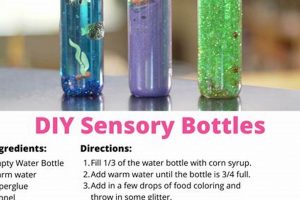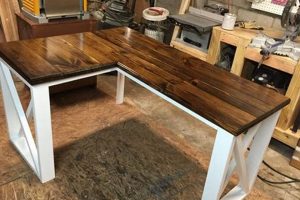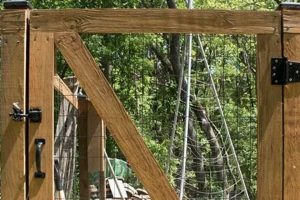A self-assembled watering method provides a tailored solution for delivering water directly to plant roots, often utilizing readily available materials and requiring minimal professional expertise for installation. For example, a homeowner might construct a network of soaker hoses connected to a timer-controlled faucet to efficiently irrigate a vegetable garden.
Such systems offer several advantages, including reduced water waste through targeted application, cost savings compared to professional installations, and increased gardening autonomy. Historically, innovative gardeners have adapted existing technologies and materials to create customized watering solutions, predating commercially available systems and demonstrating a resourceful approach to resource management.
The following sections will explore various techniques for implementing these systems, including considerations for different plant types, water source options, and maintenance strategies to ensure optimal performance and longevity.
Implementation Guidance
The subsequent guidance aims to facilitate effective construction and maintenance, ensuring optimal performance and longevity.
Tip 1: Soil Assessment. Conduct a thorough soil analysis to determine water retention properties. Sandy soils require more frequent irrigation intervals compared to clay-rich soils. Consider amending the soil with organic matter to improve water-holding capacity.
Tip 2: Drip Emitter Placement. Precisely position drip emitters near the root zone of each plant. Avoid surface watering, which promotes weed growth and water loss through evaporation. Bury emitters slightly below the soil surface for optimal efficiency.
Tip 3: Water Pressure Regulation. Implement a pressure regulator to maintain a consistent water flow rate throughout the system. Fluctuations in water pressure can lead to uneven watering and potential damage to components. A pressure of 20-30 PSI is generally recommended for drip systems.
Tip 4: Filtration Implementation. Install a filtration system to prevent clogging of emitters and tubing. Sediment, algae, and other debris can accumulate and reduce system efficiency. Clean or replace filters regularly according to manufacturer specifications.
Tip 5: Zone Division. Divide the irrigation area into distinct zones based on plant water requirements. Group plants with similar needs together to optimize water usage. Utilize separate valves and timers for each zone to ensure precise control.
Tip 6: Seasonal Adjustment. Adjust watering schedules according to seasonal changes and plant growth stages. Monitor soil moisture levels regularly and modify irrigation frequency and duration as needed. Reduce watering during periods of rainfall or dormancy.
Tip 7: Leak Detection and Repair. Regularly inspect the system for leaks or damage. Promptly repair any leaks to prevent water waste and potential damage to surrounding areas. Check connections, tubing, and emitters for signs of wear and tear.
These strategies contribute to water conservation, reduced plant stress, and enhanced garden productivity.
The following sections will provide an overview of common challenges and troubleshooting techniques related to maintaining the system’s long-term functionality.
1. Water Source Evaluation
The selection of an appropriate water source is a foundational element in the design and implementation of an effective self-assembled watering method. The characteristics of the chosen source directly influence system design, component selection, and long-term operational efficiency.
- Water Quality Assessment
The presence of sediment, minerals, or biological contaminants in the water source necessitates the inclusion of appropriate filtration mechanisms within the irrigation system. For example, well water often contains particulate matter requiring pre-filtration to prevent emitter clogging. Failure to address water quality can lead to reduced system performance and premature component failure.
- Pressure and Flow Rate Determination
The available water pressure and flow rate dictate the type and size of emitters that can be effectively utilized. Low-pressure sources, such as rainwater harvesting tanks, may require pressure-compensating emitters or booster pumps to ensure adequate water distribution. Insufficient pressure or flow can result in uneven watering and reduced system effectiveness.
- Source Reliability and Availability
The consistency of water supply throughout the growing season is a critical consideration. Municipal water sources typically offer a reliable supply, while rainwater harvesting is dependent on precipitation patterns. Fluctuations in water availability may necessitate the incorporation of storage tanks or supplemental water sources to maintain consistent irrigation schedules.
- Regulatory Compliance
Adherence to local regulations pertaining to water usage and source restrictions is essential. Certain municipalities may impose limitations on the use of potable water for irrigation purposes, promoting the utilization of alternative sources such as graywater or reclaimed water. Compliance with these regulations ensures sustainable water management practices and avoids potential penalties.
These facets of water source evaluation are intricately linked to the overall success of a self-assembled watering method. A comprehensive assessment allows for informed decisions regarding system design, component selection, and operational strategies, ultimately leading to a more efficient and sustainable irrigation solution.
2. Component Selection Criteria
The selection of appropriate components is paramount to the performance and longevity of a self-assembled watering method. The suitability of each element directly influences system efficiency, water conservation, and overall operational effectiveness.
- Material Durability
The selected materials must withstand environmental factors such as UV radiation, temperature fluctuations, and soil composition. Polyethylene tubing, for instance, offers resistance to degradation, preventing leaks and ensuring consistent water flow. Choosing inferior materials results in premature failure and increased maintenance requirements.
- Emitter Compatibility
Emitters must be compatible with the water source’s pressure and flow rate. Pressure-compensating emitters maintain consistent water delivery even with pressure variations. Incompatible emitters lead to uneven watering, stressing plants and reducing yields.
- Filtration Capability
Filters are essential to prevent clogging of emitters and tubing, particularly wh
en using water sources with sediment or organic matter. Selecting appropriate mesh sizes based on water quality ensures consistent system performance. Inadequate filtration necessitates frequent cleaning and potential component replacement. - Connection Integrity
Fittings and connectors must create secure, leak-proof seals to prevent water loss and maintain system pressure. Barbed fittings with clamps provide a robust connection, minimizing the risk of disconnections. Poorly designed connections result in water wastage and reduced system efficiency.
These criteria underscore the importance of informed decision-making in component selection for a self-assembled watering method. Prioritizing durability, compatibility, filtration, and connection integrity ensures a reliable and efficient watering system that conserves water and promotes plant health.
3. System Layout Optimization
System layout optimization is a critical factor influencing the efficiency and effectiveness of any self-assembled watering method. An intelligently designed layout minimizes water waste, ensures uniform distribution, and reduces the likelihood of system malfunctions.
- Zonal Allocation
Dividing the irrigation area into distinct zones based on plant water requirements is a fundamental optimization strategy. Plants with similar water needs should be grouped together and irrigated separately, preventing overwatering of some species while adequately hydrating others. For instance, a vegetable garden with both drought-tolerant herbs and moisture-loving leafy greens benefits from zonal irrigation.
- Emitter Placement Precision
The strategic placement of emitters directly impacts water delivery efficiency. Positioning emitters near the root zone of each plant minimizes surface evaporation and reduces weed growth. In contrast, haphazard placement leads to water waste and uneven hydration, potentially stressing plants and reducing yields.
- Elevation Considerations
Elevation changes within the irrigation area can affect water pressure and flow rates, leading to uneven distribution. Incorporating pressure regulators or adjusting emitter types based on elevation differences ensures consistent water delivery throughout the system. Neglecting elevation changes can result in some areas receiving inadequate water while others are over-irrigated.
- Path Obstruction Mitigation
Careful planning of tubing routes minimizes obstructions and sharp bends, preventing pressure drops and ensuring consistent water flow. Direct pathways from the water source to the emitters reduce friction and maintain optimal system performance. Unnecessarily convoluted routes increase pressure loss and reduce the overall effectiveness of the watering method.
Optimized system layouts enhance the performance of the method, contributing to water conservation, reduced plant stress, and increased garden productivity. These layout refinements enhance the functionality and overall effectiveness of self-assembled watering systems.
4. Automated Control Integration
Automated control integration represents a significant advancement in self-assembled watering methods, allowing for precise and efficient water management. The incorporation of electronic timers, soil moisture sensors, and other automated components enhances system performance and reduces the need for manual intervention.
- Programmable Timers
Programmable timers regulate the frequency and duration of irrigation cycles, ensuring consistent water delivery without manual oversight. These timers allow for customized watering schedules tailored to specific plant needs and environmental conditions. For example, a timer can be programmed to provide shorter, more frequent watering during hot, dry periods and longer, less frequent watering during cooler, wetter periods. This automation minimizes water waste and promotes optimal plant health.
- Soil Moisture Sensors
Soil moisture sensors provide real-time feedback on soil hydration levels, enabling dynamic adjustment of irrigation schedules. These sensors detect when the soil reaches a predetermined dryness threshold, triggering the irrigation system to activate. This feedback loop prevents overwatering, conserving water and reducing the risk of root rot. Agricultural applications commonly employ soil moisture sensors to optimize water usage and maximize crop yields.
- Weather-Based Controllers
Weather-based controllers utilize local weather data, such as rainfall and temperature, to adjust irrigation schedules automatically. These controllers access online weather forecasts and modify watering patterns based on anticipated conditions. For instance, a weather-based controller will suspend irrigation if significant rainfall is predicted, preventing water waste and minimizing the potential for soil erosion. This technology enhances water conservation efforts and promotes sustainable gardening practices.
- Remote Monitoring and Control
Remote monitoring and control systems enable users to manage their irrigation systems from a distance via smartphones or computers. These systems provide real-time data on system performance and allow for adjustments to watering schedules remotely. This capability is particularly useful for individuals with limited time or those who travel frequently, ensuring consistent water management regardless of location. This technology facilitates efficient water usage and promotes responsible gardening practices.
The integration of automated control systems into self-assembled watering methods offers numerous benefits, including reduced water consumption, improved plant health, and increased convenience. These technologies represent a significant step towards sustainable water management and promote responsible gardening practices.
5. Routine Maintenance Protocol
The longevity and efficiency of a self-assembled watering method are directly contingent upon the implementation of a structured routine maintenance protocol. The absence of consistent maintenance inevitably leads to system degradation, diminished performance, and potential component failure. This protocol serves as a preventative measure, addressing common issues such as emitter clogging, leaks, and component wear before they escalate into significant problems.
Consider a common scenario: a homeowner constructs a drip irrigation system for a vegetable garden. Without a maintenance schedule, mineral deposits may accumulate in the emitters, restricting water flow and causing uneven watering. Similarly, rodent activity could damage tubing, resulting in leaks and water wastage. A routine inspection, flushing of lines, and pest control measures are therefore essential. The failure to address these issues will ultimately compromise the system’s effectiveness, negating the initial benefits of water conservation and targeted delivery. For example, seasonal flushing of the system removes accumulated de
bris, ensuring consistent emitter function and preventing premature component failure.
In conclusion, a well-defined and consistently executed routine maintenance protocol is not merely an optional add-on but an integral component of any successful self-assembled watering method. Proactive maintenance ensures optimal performance, extends system lifespan, and maximizes the benefits of water conservation and efficient plant hydration, ensuring the initial investment in materials and labor yields long-term returns. Neglecting this crucial aspect undermines the system’s potential and ultimately leads to increased costs and reduced gardening success.
Frequently Asked Questions
The following addresses common inquiries regarding the design, implementation, and maintenance of independently constructed watering systems.
Question 1: What constitutes a self-assembled watering method?
A self-assembled watering method is a system for delivering water to plants that is designed and constructed by an individual, typically utilizing readily available materials and requiring minimal professional assistance. These systems often employ drip irrigation or soaker hoses to provide targeted watering.
Question 2: What are the primary benefits of implementing this type of system?
The advantages include reduced water consumption through targeted application, lower installation costs compared to professional systems, increased control over watering schedules, and the ability to customize the system to specific plant needs and garden layouts.
Question 3: What water sources are suitable for a self-assembled watering method?
Appropriate water sources encompass municipal water supplies, well water, rainwater harvesting systems, and reclaimed water sources. Each source requires assessment for water quality and pressure to ensure proper system function and prevent component damage.
Question 4: How is emitter clogging prevented in a self-assembled watering system?
Clogging prevention is achieved through the installation of filtration systems that remove sediment, algae, and other debris from the water source. Regular cleaning or replacement of filters is essential for maintaining system efficiency.
Question 5: What are the key considerations for system layout optimization?
Layout optimization involves dividing the irrigation area into zones based on plant water requirements, precise emitter placement near root zones, accounting for elevation changes, and minimizing obstructions in tubing routes.
Question 6: How is a self-assembled watering method adapted for seasonal changes?
Seasonal adjustments entail modifying watering schedules based on temperature, rainfall, and plant growth stages. Soil moisture monitoring and timer adjustments are crucial for adapting the system to changing environmental conditions.
Effective implementation and consistent maintenance ensure the ongoing functionality and benefits of a self-assembled watering method.
The next section will delve into troubleshooting common issues encountered with these systems.
DIY Irrigation System
This exploration has detailed the design, implementation, and maintenance of a diy irrigation system, underscoring its potential for water conservation and targeted plant hydration. Essential elements include water source evaluation, component selection, system layout optimization, automated control integration, and a rigorous routine maintenance protocol.
The enduring success of a diy irrigation system necessitates a commitment to responsible resource management and proactive system oversight. Consistent adherence to best practices ensures both environmental sustainability and the continued vitality of cultivated landscapes. Ignoring these tenets compromises the initial investment and undermines the inherent benefits of this approach.







